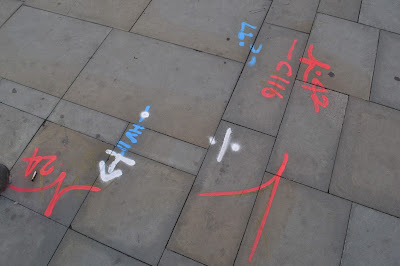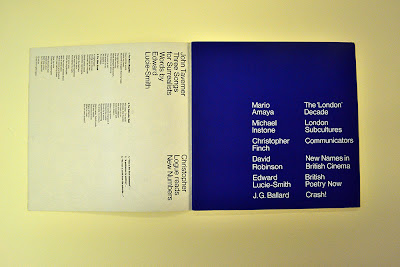Monday, 26 August 2013
Monday, 19 August 2013
WE Conference, Jerusalem Season of Culture
WE Conference is part of the Jerusalem Season of Culture, it ran from 14th - 15th August. I was invited to take part in this festival, install work in a space and hold discussions about collective work. This was collaborated with Adam Murray and Rob Griffiths. Although this project wasn't directly linked to what projects I am working on with my course work, the approach and output does. The idea was to bring parts of what inspired us to start the collective. We installed two prints, one of an industrial landscape of Preston. The other a portrait by Jamie Hawksworth. Then we installed elements of my bedroom which our first zine was produced. This included posters, flyers, a flag, and Polaroids. Rob Griffiths produced a Prestonian soundscape. We reproduced Preston Bus Station's 'famous' yellow arrows, and finally we installed a live webcam of the Preston landscape. Using a broad range of mediums brought a more informative view of how and why we started the collective. For me this was also an experiment, to see if this method would work for my project on the new Metro system.
After researching artists who document changing landscapes like Robert Adams and Lewis Baltz of the New Topographics, and the ongoing mammoth archive of Mass Observation, I began to see the limitations of the images that they produced. I am aware that Mass Observation project wasn't solely photographic based, but the New Topographics mainly was. Their approaches are still relevant but with new media, more can be now be brought to a project. But who is my audience and what is the point of producing this material? This is where the ethos of such collectives and projects from the past still links strongly today. Urban sprawl and new developments often get over looked as subjects of creative practice, often because they are seen as unimportant or an eye sore. In 'Learning from Las Vegas' by Robert Veturi, it talks about how a new developing space strongly reflects current issues of the time (FIND QUOTE + RETHINK) and needs to be studied to understand and address what is happening in society.
My documentation of the Metro could be a starting point for discussion (STORY TELLING? STORY ABOUT Scrapbook) about everyday life now and what change this new development will bring. Below I have experimented with a few images I have made around the Metro lines. The expressive temporary construction markings could be reproduced alongside photographs of the landscape. I have also included a video clip of which the sonic artist I'm working with has produced the audio for.
Thursday, 8 August 2013
Shelley Parker - Power Station
'Power Station' by Shelley Parker is the results of a one year residency at SPACE in London. The work was mainly inspired by Dungeness Power Station in Kent. Over the course of the year Parker produced music and staged performance's in response to the Power Station. The soundscape is definitly the direction I want to explore within this project. The all to familiar humming of power surging through the station paints a picture in everybody's mind. Using sounds that are overlooked is the most effective approach to trigger familiarity. This will also cause the audience to react to the work, to understand where they recognize the sound. This is where imagery could play a major role by causing the audience to remember the sound while highlighting what audio we unconsciously hear everyday..
Wednesday, 7 August 2013
Audio / Visual Examples Research at Special's Collection
Today I visited the Special's Collection at MMU. My intention was to research artists who have incorporated audio with publication based work. On reflection of my recent explorations of the Metro's new districts and stops, one major aspect of my field studies were missing. Audio. Has this been brought to my attention due to working with sound in my previous project 'Scrapbook'? Maybe. I think I am much more aware of the potential audio has to bring to an image based project, and with trams screeching past me, it was hard to ignore. I have been in touch with an artist who will be producing a soundscape from field recordings he has made and manipulated while travelling the new Metro lines. I am aware that this isn't a new approach to photography, but I wanted to see a few more traditional examples about how it has been tackled in the past with physical publication's. I will soon be researching into new media's such as flash and web based projects to see how contemporary artists have worked combining these mediums.
Aspen No.7 - 'British Box in 15 Sections'
Aspen was created by Phyllis Johnson, and seemed to be issued sporadically for around ten years from 1965. Her aim was to produce a multimedia publication with the intention to give the featured artists a broader choice of output. 'We wanted to get away from the bound magazine, which is really quite restrictive'. The idea of a publication being restrictive on its own is something I can relate to, a publication doesn't have to be strictly image based, many medias can be involved. What struck me the most about this publication was how diverse and fresh this work still seems. Even compared to some contemporary photographers who seem to almost settle on an image being flat in a magazine or hung in a white cube. This particular issue has various fold out posters, Ossie Clark's 'British Knickers' underwear making pattern's, Eduardo Paolozzi's 'The Gay Atomic Colouring Book', and audio recordings by Yoko Ono & John Lennon, which were pressed on Flexi-disc (previous issues have also included Super 8 video's). Without the option to produce these playful interactive projects, they wouldn't work. A still image of the underwear pattern split between two pages in a magazine wouldn't give you the scale or the texture of the traditional material it was produced on. As I carried on sifting through all the material of the box set publication, I began to realize that I was unable to listen to the actual audio (which I managed to listen to online after I left the library). This project was created to be experienced by a group of people. Colour the book together while the audio is playing in the background, discuss the ideas. Is this approach restricting? Some people may not have access to audio playing equipment, and certain audio mediums become quickly obsolete. Also in some cases the equipment may only be accessible to one person at a time. Creating an installation with both images and audio would compliment the mediums while broadening your audience. This will be something I will consider when finalizing the Metro project.
Helen Douglas & Zoé Irvine - Illiers Combray
Illiers Combray was produced in 2004 by Helen Douglas & Zoé Irvine. It takes the form of a constatina book with two mini audio CD's. The project was produced over a week long visit to Illiers after being insired by the novel 'In Search of Lost Time' by Marcel Proust. What intrigued me the most about this project was how similar the images and audio were to each other. Each photograph seemed to blend from one to another as if it was a constant mural telling a story. The audio complemented well as it seemed to weave through the images as delicatly as the images merged into each other. This is a strong example of how audio and visual can work together, Rather than being seen as two different mediums addressing the same themes, they come together as one.
Phyllis Johnson quote from Modernism 101
Subscribe to:
Comments (Atom)

























































